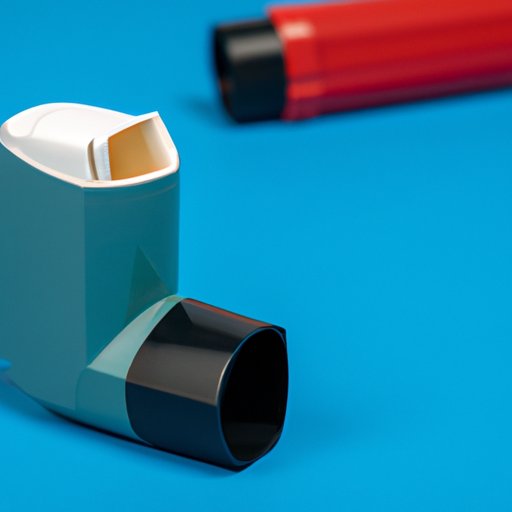Introduction
If you suffer from asthma, then you know how important it is to have your rescue inhaler with you at all times. It can be a lifesaver during a sudden flare-up. However, you may wonder how often you can use your inhaler without putting your health at risk. In this article, we will discuss everything you need to know about using a rescue inhaler safely and effectively.
When to Reach for Your Rescue Inhaler: A Guide for Asthma Sufferers
Asthma is a chronic respiratory condition that affects millions of people worldwide. The common signs and symptoms of asthma include wheezing, chest tightness, shortness of breath, and coughing. These symptoms can vary in severity, and some people may experience sudden flare-ups known as asthma attacks.
A rescue inhaler contains short-acting medication that helps to relieve symptoms quickly during an asthma attack. You should use your rescue inhaler when you experience symptoms like coughing, wheezing, and shortness of breath. However, if your symptoms persist or worsen despite using your inhaler, seek emergency medical care immediately.
You should also use your inhaler before any activity that might trigger an asthma attack, such as exercise or exposure to allergens. It is essential to be familiar with your symptoms and triggers to prevent asthma symptoms from getting worse.
Understanding the Limitations of Your Rescue Inhaler: How Often is Too Often?
While a rescue inhaler is beneficial, overusing it can be harmful. Overuse of rescue inhalers can lead to serious health problems such as reduced lung function or increased risk of heart attack.
Your doctor will recommend a specific dosage and frequency for using your inhaler based on the severity of your asthma symptoms. In general, you should only use your rescue inhaler as needed, which could be several times a week or several times a day.
To prevent overuse, keep track of your rescue inhaler usage. If you find yourself using it too much, contact your doctor immediately to discuss a possible change in treatment plan.
Managing Asthma Symptoms: Balancing the Use of Rescue Inhalers With Long-Term Control Medications
A rescue inhaler is not intended to replace your long-term control medications, which work to prevent inflammation and keep your airways open over time. For optimal asthma management, you need to use both types of medications in combination.
You should work with your doctor to develop an asthma action plan that outlines when and how to use each medication. Your plan should also include a written record of your rescue inhaler usage and asthma symptoms to help you and your doctor monitor your condition.
The Importance of Proper Inhaler Use: How Often Should You Use Your Rescue Inhaler?
Proper inhaler use can make a significant difference in managing asthma symptoms. Your doctor will show you how to use your inhaler correctly and provide you with written instructions.
Common inhaler mistakes include inhaling too quickly, not shaking the inhaler before use, and not holding your breath for several seconds after inhalation. It’s crucial to avoid these mistakes and use your inhaler according to your doctor’s instructions.
You should also clean your inhaler regularly to prevent blockages and ensure that it delivers the correct dosage of medication. Follow the cleaning instructions provided by the manufacturer carefully.
The Role of Rescue Inhalers in Asthma Treatment: Dispelling Common Misconceptions
There are many myths and misconceptions about rescue inhalers, including the belief that you can become addicted to them. This is not true. However, overuse of rescue inhalers can lead to health problems, as mentioned earlier.
It’s important to understand that a rescue inhaler is not a substitute for long-term control medications. You should follow your doctor’s prescribed treatment plan and use your inhaler as needed.
If you have concerns or questions about your rescue inhaler or asthma treatment plan, do not hesitate to speak with your doctor. Maintaining open communication with your healthcare team can help you manage your asthma effectively.
When to Contact Your Doctor About Rescue Inhaler Use: Tips for Keeping Your Asthma Under Control
Regular check-ups with your doctor can help you manage your asthma and prevent flare-ups or emergency situations. You should also contact your doctor if you experience any of the following symptoms:
- Increased use of your rescue inhaler compared to your usual frequency.
- Worsening asthma symptoms.
- Side effects from your medication.
Your doctor may adjust your treatment plan or medication dosage based on your symptoms and asthma control level. Remember, your asthma treatment plan needs to be tailored to your specific needs and symptoms.
Conclusion
A rescue inhaler is a crucial tool for managing asthma symptoms safely and effectively. However, it’s essential to understand its limitations and proper use to prevent overuse and health complications.
By following your doctor’s prescribed treatment plan, maintaining good inhaler technique, and staying aware of your symptoms, you can manage your asthma and maintain your quality of life.
(Note: Is this article not meeting your expectations? Do you have knowledge or insights to share? Unlock new opportunities and expand your reach by joining our authors team. Click Registration to join us and share your expertise with our readers.)
